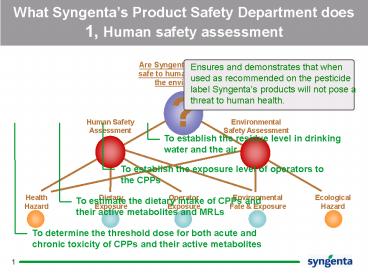What Syngentas Product Safety Department does - PowerPoint PPT Presentation
1 / 12
Title:
What Syngentas Product Safety Department does
Description:
Ensures and demonstrates that when used as recommended on the ... Non-target arthropods (beneficials) Earthworms & other soil organisms. Non-target plants ... – PowerPoint PPT presentation
Number of Views:32
Avg rating:3.0/5.0
Title: What Syngentas Product Safety Department does
1
What Syngentas Product Safety Department does
1, Human safety assessment
2
In order to establish dietary exposure, we need
to know
1. the fate of a chemical in basic foods 2. the
quantities of parent and its breakdown products
in these foods
3
Studies conducted to estimate dietary residue
level
Metabolism Primary crop Crop rotation Livestock
- ruminant and poultry Elevated temperature
hydrolysis
Residues Magnitude of Residue Rotational
Crop Livestock Feeding Study Processing
Residue in food (mg/kg)
4
Assessing Mammalian Toxicity
are performed to characterize the hazard
1. A wide range of toxicological studies
3. The threshold values are then compared with
the estimated exposure levels to assess risks
An example where NOEL 10 mg/kg
2. The data obtained is inspected to
determine the following threshold values
- 1. No Observed Effect Level (NOEL) the highest
level of continual exposure to a chemical which
causes no significant adverse effect - 2. Acceptable Daily Intake (ADI) the daily dose
that will cause no adverse effects over a
lifetime - ADI NOEL / 100
- Assume that the most sensitive animal is 10 times
less sensitive than the typical human
(Interspecies) - Assume that some humans are 10 times more
sensitive than the typical human (Intraspecies) - 3. Acute Reference Dose (ARfD) the dose that
will cause no adverse effects after one dose - 4. Acceptable Operator Exposure Level (AOEL)
the daily dose that will cause no adverse effects
in those applying the compound
5
Risk Meter
6
What Syngentas Product Safety Department does
2, Environmental safety assessment
7
Assessing Environmental Fate and Exposure
- Laboratory Studies
- Fate Processes
- Field Studies
- Actual residue
- Movement
- Simulation Modelling
- Prediction
- Sensitivity
8
(No Transcript)
9
Establish Environmental Exposure Level
- Simulation Modelling
- The data from lab and field studies are used to
establish the Predicted Environmental
Concentrations (PECs) of chemicals and their
metabolites using specific models. - Soil, Water, Air
10
Ecological Hazard
- Non-target populations may be exposed to
pesticides via soil, water and/or food - Need to evaluate and demonstrate safety to
non-target populations using predicted exposures
11
Ecological Effects
- Evaluate safety to wildlife
- Data requirements toxicity to
- Mammals
- Birds
- Honeybees
- Non-target arthropods (beneficials)
- Earthworms other soil organisms
- Non-target plants
- Fish
- Aquatic invertebrates
- Algae
- Aquatic plants
12
Ecological Effects
- Test Indicator Species
- Measure Endpoints
- Standardised methods (eg OECD)
- Mortality
- Reproduction/growth/development
- Progressive Testing
- Laboratory Studies
- Semi-field Studies
- Field studies
- Risk assessment
- Effects vs exposure
- Apply safety factors
- Unacceptable/acceptable risk
- Higher tier assessment if necessary































